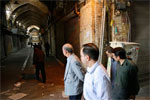 AFP: Iran’s powerful bazaar merchants and Shiite clergy spearheaded the 1979 Islamic revolution, but their role on the country’s political scene has waned with developments in society and the advent of new technology, analysts say. By Farhad Pouladi
AFP: Iran’s powerful bazaar merchants and Shiite clergy spearheaded the 1979 Islamic revolution, but their role on the country’s political scene has waned with developments in society and the advent of new technology, analysts say. By Farhad Pouladi
 QOM, Iran (AFP) — Iran’s powerful bazaar merchants and Shiite clergy spearheaded the 1979 Islamic revolution, but their role on the country’s political scene has waned with developments in society and the advent of new technology, analysts say.
QOM, Iran (AFP) — Iran’s powerful bazaar merchants and Shiite clergy spearheaded the 1979 Islamic revolution, but their role on the country’s political scene has waned with developments in society and the advent of new technology, analysts say.
The merchants, or bazaaris, are viewed as a force for conservatism in Iranian society and, in alliance with the clergy, they have already played a key part in Iran’s history.
The two groups were crucial in orchestrating successful protests against a British monopoly tobacco concession in 1891-92.
The alliance also took part in Iran’s Constitutional Revolution of 1905-11, forcing the ruling Qajar dynasty to form a rudimentary parliament.
More recently, the bazaaris contributed to the collapse of the regime of Mohammad Reza Pahlavi during the 1979 Islamic revolution, when they went on long strikes.
But analysts believe their “influence” has waned, but not disappeared, with advent of modern technology and the evolution of society since 1979.
Mohammad Saleh Sedghian, head of the Arabic Centre for Iranian Studies in Tehran, told AFP that the two groups still have a say in the country’s politics.
“The bazaar and the clergy are still influential in post-revolution Iranian society, but not in the same way,” said Sedghian.
“Society has evolved in a way that has decreased their direct influence.”
Sedghian said factors such as the rise of social networks, satellite television and mobile technology have helped bring this about.
Although satellite receivers are officially banned in Iran, the dishes have mushroomed on rooftops across the country.
The police occasionally crack down on the dishes, and authorities and clerics regularly exhort Iranians to snub satellite television stations, but to little avail.
Iran also has an Internet penetration rate of 61 percent, and despite government monitoring, social networks like Facebook, Twitter and YouTube are popular.
Seminarians in the Islamic republic’s clerical nerve centre, Qom, acknowledge their “influence” has declined.
But a 30-year-old seminary school student who has studied in Qom told AFP on condition of anonymity that this was down to the clerics themselves.
“The influence has decreased and that is because some officials who are clerics disregard their own preaching,” he said.
“They are not pushing domestic television to broadcast more Islamic programmes… even they are not doing enough for the spread of Hijab.”
Another cleric, who only gave his last name, Akbari, went further; “some dishonest political clerics’ behaviour has contributed to the decline of their influence.”
But Ebrahim Saadian, who has been preaching for 24 years, said Iranian youths are still prepared to do their religious duty.
“The clerics should change their approach to appeal more to the youths… but at the end of the day our youths are religious and listen to the clerics if there is a call of duty,” the 50-year-old said.
Ali Vaez, the Brussels-based International Crisis Group’s senior analyst on Iran, agrred that two-tiered influence has dwindled.
“The bazaaris and clerics have been significantly weakened over the past 20 years.
“New networks, which are mostly affiliated with the military and state institutions, have replaced them and are now vying for the scarce resources of wealth and power,” said Vaez.
Many national projects, such as the construction of dams, piers, oil and gas pipelines and even imports and exports have been carried out by Iran’s elite Revolutionary Guards, according to the media and experts.
Hirad Hatami, a conservative columnist on economic issues said he believes the influence of the bazaaris has shifted from political to guild issues.
“When it comes to issues related to their guild, the bazaaris are effective,” he said.
This influence was evident in 2008 and 2010, when shopkeepers in Iran’s traditional bazaars and Tehran’s grand bazaar went on strike for days to protest against the introduction of value added tax amid mounting price pressures.
Javad, a tea seller in the grand bazaar, blames new ways of shopping, in particular western influences, for the merchants’ decline in influence.
“We have seen our customers decreasing as new shops and Western-style chain supermarkets increased in different part of Tehran,” he said.
“If we close our shop here, not many people will be affected,” Javad mused. “So maybe our importance has decreased.”


